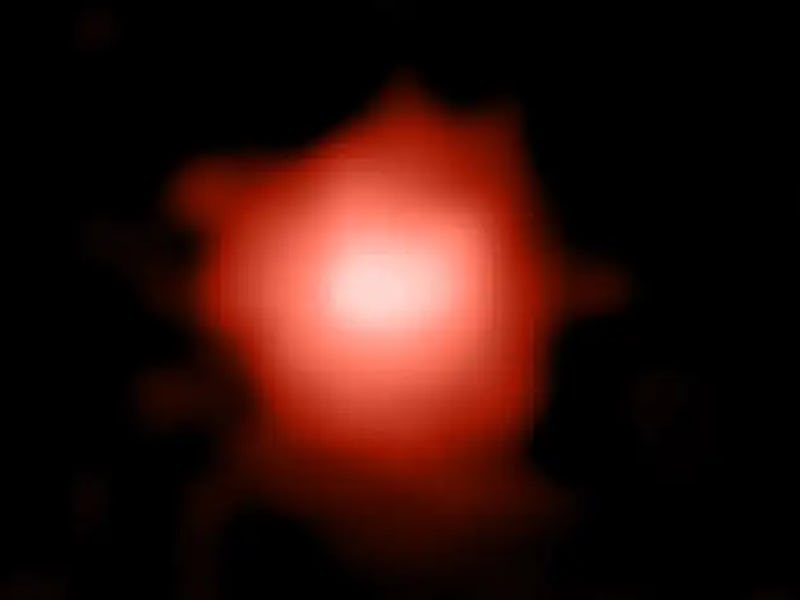Webb Telescope data reveals oldest galaxy ever seen — and it's not what astronomers expected
A team of astrophysicists discovered the ancient galaxy in publicly available data from Webb's first science observations.

During some of the James Webb Space Telescope’s first scientific observations, a team of astrophysicists just discovered the oldest galaxy ever observed, and it’s a cosmic surprise that challenges key ideas about what the early universe was like.
What’s new — The galaxy, dubbed GLASS-z13, is 13.5 billion light years away. Webb saw light from the galaxy as it looked just 300 million years after the Big Bang, when the universe was still very young.
GLASS-z13 beats the previous record by about 100 million years; in 2016, the Hubble Space Telescope discovered a galaxy about 13.4 billion light years away, which astronomers call GN-Z11. But besides smashing yet another cosmic record (something that’s already become routine for Webb, just a week into its 20-year mission), GLASS-z13 smashes some assumptions about when galaxies started to form, how quickly they grew, and how many we can expect to find in the most distant reaches of the universe.
In a recent preprint paper, Harvard University astrophysicist Rohan Naidu and his colleagues describe the first few hundred million years after the Big Bang as “the last major uncharted epoch in the history of the universe.” Until now, astronomers had only observed a single galaxy from that little-known period: good old GN-Z11. Most models predicted that such ancient galaxies would be scarce, small, and dim. But GLASS-z13 is surprisingly bright, so bright that Naidu and his colleagues describe it as “remarkably luminous” in the title of their scientific paper, which is usually a venue for being as dry as possible.
GLASS-z13, pictured here, formed in the first few hundred million years of the universe’s existence — the blink of a cosmic eye.
Webb also discovered another surprisingly bright young galaxy, GLASS-z11, in the same relatively small patch of sky (an area about 1.6 times wider than the full Moon viewed from Earth). GLASS-z11 is about 13.4 billion light years away, roughly the same distance as GN-Z11. Where astronomers previously only knew of one galaxy dating back to the first few hundred million years of the universe, now they know about three. And they’ve only searched a very small area of the sky so far.
That seems to defy models that predict there shouldn’t be very many bright galaxies in the oldest parts of the universe. Those models, according to Naidu and his colleagues, “require a survey area ten times larger than we have studied here to find such luminous sources at such high redshifts.”
Why it matters — If Naidu and his colleagues are correct, GLASS-z13 and GLASS-z11 may even hint that galaxies started forming earlier than we thought.
They built computer models based on the data from Webb’s NIRCam instrument, and those models suggest that by 300 to 400 million years after the Big Bang, each galaxy had formed a collection of stars with a total mass of around 1 billion times that of our Sun. That, along with their surprising brightness at such an early moment in the universe’s evolution has “implications for just how early these galaxies began forming,” they wrote in their paper.
“JWST observations may identify relatively bright galaxies to much earlier epochs than might have been anticipated,” wrote Naidu and his colleagues.
Here’s the background — In other ways, the newly-discovered galaxies match astrophysicists’ expectations: they’re both small compared to our own Milky Way, and they seem to have relatively simple structures.
GLASS-z13 is about 1,600 light years wide, while the slightly closer GLASS-z11 is about 2,300 light years wide. For comparison, our galaxy is about 100,000 light years wide. And based on what Naidu and his colleagues could glean from the NIRCam data, GLASS-z11 appears to be a disc-shaped galaxy, without the fancy spiral arms of galaxies like our Milky Way (or the doomed dancers of Stephan’s Quintet). That’s about what astrophysicists expected from the oldest galaxies in the universe.
The Webb SMAC field gives astronomers a glimpse at some of the most distant objects ever seen.
How did small, simple galaxies like GLASS-z11 grow into large spiral galaxies like our Milky Way? Astrophysicists are fairly sure that it happened in a series of cosmic collisions. The first small galaxies merged to form larger ones, and that process repeated several times — and is still happening. Earlier this year, astrophysicists even found physical evidence of an ancient merger in the Large Magellanic Cloud, a small galaxy adjacent to our own.
That process of galactic evolution is one of the major themes of Webb’s first year of science. Some of Webb’s first observations — two programs called GLASS and CEERS—– are focused on how the first galaxies formed and how they evolved. And Naidu and his colleagues used the publicly-available data from those observations to find GLASS-z13 and GLASS z-11.
What’s next – Technically, GLASS-z13 and GLASS-z11 are just candidates for the title of oldest known galaxies. Naidu and his colleagues are confident enough to have written the paper, but it hasn’t yet been peer-reviewed by other astrophysicists. And more data from Webb’s instruments will help confirm whether the two galaxies really are as old as they look.